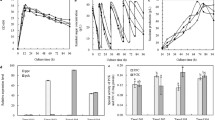Abstract
In an oxystat, the synthesis of the fermentation products formate, acetate, ethanol, lactate, and succinate of Escherichia coli was studied as a function of the O2 tension (pO2) in the medium. The pO2 values that gave rise to half-maximal synthesis of the products (pO0.5) were 0.2–0.4 mbar for ethanol, acetate, and succinate, and 1 mbar for formate. The pO0.5 for the expression of the adhE gene encoding alcohol dehydrogenase was approximately 0.8 mbar. Thus, the pO2 for the onset of fermentation was distinctly lower than that for anaerobic respiration (pO0.5≤ 5 mbar), which was determined earlier. An essential role for quinol oxidase bd in microaerobic growth was demonstrated. A mutant deficient for quinol oxidase bd produced lactate as a fermentation product during growth at microoxic conditions (approximately 10 mbar O2), in contrast to the wild-type or a quinol-oxidase-bo-deficient strain. In the presence of nitrate, the amount of lactate was largely decreased. Therefore, under microoxic conditions, the pO2 appears to be too high for (mixed acid) fermentation to function and too low for aerobic respiration by quinol oxidase bo.
Similar content being viewed by others
Author information
Authors and Affiliations
Additional information
Received: 7 February 1997 / Accepted: 2 May 1997
Rights and permissions
About this article
Cite this article
Becker, S., Vlad, D., Schuster, S. et al. Regulatory O2 tensions for the synthesis of fermentation products in Escherichia coli and relation to aerobic respiration. Arch Microbiol 168, 290–296 (1997). https://doi.org/10.1007/s002030050501
Issue Date:
DOI: https://doi.org/10.1007/s002030050501




